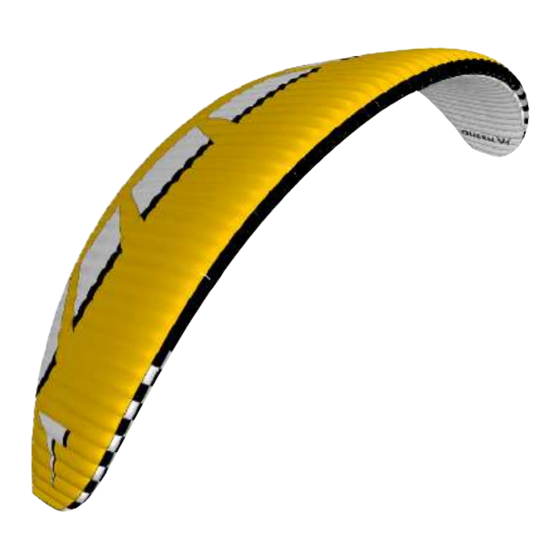
Table of Contents
Advertisement
Quick Links
Advertisement
Table of Contents

Summary of Contents for Triple Seven QUEEN Series
- Page 1 LTF / EN...
-
Page 2: High Performance En/Ltf-C
High performance EN/LTF-C USER MANUAL Version 1.0, Date: 28.06.2013... -
Page 3: Table Of Contents
IV. Introduction XI. Safety and responsibility characteristics of your new glider. It contains instructions 7.7. Minimum sink Welcome to the Triple Seven Team! We are excited that on how to use and maintain the wing, however, its XII. Guarantee IV.i. Welcome ... - Page 4 »Reinforced leading edge (RLE), Smooth trailing edge reinforcements (STE) together with (BPI) for greater stability and good gliding performance on wide speed range »BPI - back position intake technology for spin and stall resistance and good stability at accelerated flight. »Low induced drag wing tip (LDW), optimized washout with two additional floating cells.
-
Page 5: Queen
Designer’s thoughts My goals while developing this glider was to make high performance XC machine and competitions introductory glider with EN/ LTF-C class ease of flight. While designing this wing for performance, we gave great emphasis to refined sail tension internal construction and line reduction. -
Page 6: Before Flight
Every glider has to be adjusting the length of the harness chest strap according to the checked by a Triple Seven dealer, however, as a pilot you want The length of the brake lines has already been adjusted by the lengths used during certification. -
Page 7: Weight Range
Weight range Wing inflation Flying QUEEN Each size of the QUEEN is certified for its own weight range. The Still being on the training slope and having prepared and checked above mentioned weight includes the weight of the pilot and everything, inflate your wing and play with it to get a feel of your complete paragliding equipment, together with the glider, harness, new glider while ground handling. -
Page 8: Final Preflight Check
moves, walk around and correct it again. It is always advisable to practice and improve proper launching briefly pulling the tangled lines, immediately fly to the landing risk of a collapse is higher in accelerated flight. Additionally, the 4. Inspect the harness, reserve, speed system and all connections. techniques as this reduces unnecessary additional stress before zone and land safely. -
Page 9: Flying In Turbulence
control this event, apply both brakes slightly when the collapse Be prepared for the glider to surge forward, compensating the to let it fly normally. problematic because of the input itself or its intensity; but due to occurs and then instantly release the brakes to let the glider fly. surge with brake input if necessary. -
Page 10: Winch Launch
manoeuvres should be learned at your flying school as a part of (Big ears, B-stall, Spiral) and should only be trained gradually and • If practicing the spiral dive low, a pilot may not have enough Landing paragliding pilot training. Nevertheless, we recommend practicing always at high altitude. -
Page 11: Maintenance
Major repairs, such as replacing panels, should and the canopy material (wash with fresh water). only be carried out by a Triple Seven distributor or Triple Seven. If • Avoid bending your lines, especially in a small radius. -
Page 12: Packing Queen
Packing QUEEN 3. FOLD LEADING EDGE BACk TOWARD TRAILING EDGE AND ALIGN THE CELS 1. FOLD THE GLIDER LIkE HARMONICA 4. FOLD THE GLIDER IN THREE PARTS 2. ALIGN THE CELLS 5. FINISHED... -
Page 13: Technical Data
Technical data 1. Suspension lines 2. Risers 3. Main lines 4. Middle cascades 5. Upper cascades 6. Brake lines 1. Canopy 2. Bottom surface 3. Top surface 4. Leading edge 5. Trailing edge 6. Intake cell openings... -
Page 14: Technical Data
Technical data Materials description QUEEN risers arrangement SIZE QUEEN S QUEEN M QUEEN L CANOPY FABRIC CODE CELLS NUMBER Upper surface NCV Skytex 38 Universal 1. A1 riser FLAT AREA 23.5 25.5 27.3 Bottom surface NCV Skytex 38 Universal 2. A2 riser, (Ears) SPAN 12.6 Profiles... -
Page 15: Line Lengths Queen M
Line lengths QUEEN M Line plan QUEEN Triple Seven QUEEN M Lines Length (mm) LINE CHECK First gallery 6820 6884 Lines A Lines B Lines C Lines D BR lines 6712 6746 1356 1298 6666 6706 1248 1180 6698 6802... - Page 16 Line lengths QUEEN L Triple Seven QUEEN L Lines Length (mm) LINE CHECK First gallery 7090 7124 Lines A Lines B Lines C Lines D BR lines 6980 6982 1404 1344 6932 6944 1294 1222 6968 7044 1294 1218 6791...
- Page 17 By purchasing this equipment you are responsible to be a certified paragliding All Triple Seven products are fully warranted for 12 months, against material defects that are pilot, and you accept all risks involved in paragliding activities, including serious injury and not the result of normal wear or accidental damage.
-
Page 18: Registration Information
Newsletter register: www.777gliders.com/newsletter/subscriptions As a new Triple Seven pilot we invite you to contact us in case of any technical or practical issues regarding equipment or techniques. We also invite you to send us your flying photos, Ask questions, make suggestions videos or even postcards.





Need help?
Do you have a question about the QUEEN Series and is the answer not in the manual?
Questions and answers